Posts filed under ‘Orchids’
‘Bucky,’ the Stinkiest Bulbophyllum
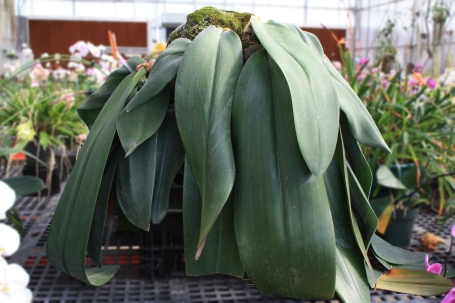
“Bucky’ and its large leaves
Every orchid has an interesting story. Once you look beyond their beauty, other captivating qualities emerge about virtually all of them. However, there are some that stand out and make their presence known in ways that simply cannot be ignored. Whether you like them or not, indifference is unlikely to be your response. In this regard, there is nothing subtle about Smithsonian Gardens’ magnificent specimen of Bulbophyllum phalaenopsis. Charmed by its pendant glossy leaves and their resemblance to a beaver’s tail, the donors of this magnificent specimen named it ‘Bucky’; a name that lives on.
At the time it was originally acquired, few people outside of Asia had seen this species, though many read about it and its remarkable ecology. The inflorescence (flower head) consists of a cluster of about 15 to 20 reddish-brown (meat-colored) flowers covered with papillae (fleshy projections) said to resemble wriggling maggots. Charming! Since it targets female carrion flies as its pollinator, engaging in ‘brood site deception,’ it also evolved a fragrance to match its appearance. Early writings about it claim that its blossoms emitted an aroma reminiscent of the stench of 1000 dead elephants rotting in the sun. While this is surely hyperbole, Smithsonian Gardens staff have been waiting for many months to experience Bucky’s olfactory charms. Incredibly, buds were forming under one of its huge floppy leaves which we didn’t observe until a visitor spied them during a greenhouse tour. We certainly would have noticed them the next day when they opened and started their fragrance treat, though, making the greenhouse almost uninhabitable for a few days.
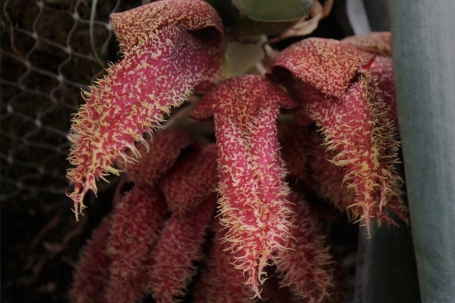
Inflorescence of Bulbophyllum phalaenopsis
A monstrous plant from lowland Papua New Guinea, Bucky loves to be warm and humid all the time. Given its robust girth and thick pseudobulbs (storage organs in the stem), we water it daily and feed it frequently. It is the most famous species in Bulbophyllum section Macrobulbon, of which the Smithsonian Gardens Orchid Collection has an almost complete set. They all share the same pollination strategy so more very stinky orchids are soon to come! The surprising species epithet, ‘Phalaneopsis,’ was given because superficially the plant resembles Phalaenopsis gigantea, the largest Phalaenopsis species (native to Borneo). Other than both being in the orchid family, however, they are not at all closely related.
– Tom Mirenda, Smithsonian Gardens Orchid Collection Specialist
Vanilla blooms abound!

This past December, Smithsonian Gardens large trellised specimen of Vanilla pompona graced our greenhouses with luxurious blooms. Beautiful umbels of impressive, successively blooming flowers appeared at every leaf node on this huge vining orchid. Even though each individual flower lasts less than 24 hours, so many new blooms opened daily that it was a true spectacle for several weeks. A sister species to the better known Vanilla planifolia, the source of the delicious flavoring we all know and love, V. pompona differs in having a much larger, gullet shaped lip. Its seed pods are also used to make a type of vanilla extract, though only locally in Costa Rica and Panama where it grows. Many Vanilla species occur in tropical regions around the world (circumtropical) and therefore are thought to be among the most ancient of orchids, perhaps with a common ancestor existing when the continents were contiguous. Most of these other species are not used for flavoring.

With rampantly growing vines, these orchids climb quickly and become massive specimens in a short time. Generally, they will only bloom when they are very large and mature. Like a philodendron, their plant habit is a combination of terrestrial and epiphytic. Starting as terrestrial plants with thick fibrous roots, aerial roots arising from the leaf axils clasp the sides of trees as they climb upward searching for higher light in which to bloom. They are easy to propagate from cuttings, but as with any succulent, it is best to let the cuts callous for a few days before planting them or they are sure to rot. Indeed, Vanilla plants in Madagascar plantations have fallen prey to a fungal disease in recent years. We produce pods on our plants by pollinating the flowers by hand (“selfing”) as they do in vanilla plantations in Madagascar and the Mascarene Islands.
– Tom Mirenda, Smithsonian Gardens Orchid Collection Specialist
January 10, 2017 at 3:49 pm smithsoniangardens Leave a comment
Brassavola nodosa (the Lady of the Night orchid)
Even though they are not especially rare or particularly showy, orchids from the genus Brassavola are quite popular. These sturdy, succulent, epiphytic plants live in a variety of habitats throughout Central and South America. Due to their wide-ranging prevalence and adaptability, they are easy to find in and out of the wild. Growing contentedly in bright shade to high light conditions just short of full sun, and adapting well to intermediate to warm growing conditions, these plants often grow into lush specimens. Free flowering, they usually bloom at least twice a year on their newest growths. Smithsonian Gardens is lucky to have several different clones of this species in its Orchid Collection, many of which have grown into massive, spectacularly blooming specimens.
Brassavola nodosa’s supremely elegant, ghostly white flowers exhibit a pollination strategy, similar to Darwin’s Orchid (Angraecum sesquipedale). Pale colors show up better in the moonlight, and this feature–combined with a sweet, wafting crepuscular or nocturnal fragrance–ensures that the blossoms can be found easily by their pollination partners.
-Tom Mirenda, Smithsonian Gardens Orchid Specialist
November 22, 2016 at 7:51 am smithsoniangardens Leave a comment
The Critical Importance of Water Quality for Living Collections: Planning Ahead
Objects and artifacts in a museum collection are typically housed in cases and cabinets with drawers or shelves. As a living museum, Smithsonian Gardens’ plant collections are maintained in the landscape and in a large greenhouse facility. Because plants are living specimens that require vitamins, nutrients and other sources of energy, they must be monitored and nurtured daily. Water is a critical component of this care. Photosynthesis, transpiration (water movement through a plant and subsequent evaporation from plant leaves), and the transfer of vitamins and minerals from the soil to the plant are all dependent on the presence of water.
Water quality and availability are key factors to plant maintenance in a public garden. Things like droughts, floods, and other natural disturbances must be considered when developing a plan of care for each garden and/or collection. Throughout its gardens and landscapes, Smithsonian Gardens utilizes an irrigation system that uses 30-50% less water than conventional watering, improves plant growth by extending watering times, prevents soil erosion and nutrient runoff, and ensures that plants are watered without wetting leaves, which helps prevent fungal disease.

Irrigation system visible during construction of Folger Rose Garden
Water quality is also of critical importance when it comes to successful orchid cultivation and maintenance. Orchid species exposed to municipal water–such as that which the Smithsonian Gardens Orchid Collection (SGOC) currently uses–exhibit detrimental physical manifestations caused by the accumulation of salts in the growing medium. These adverse effects include leaf tip burn, decreased plant vigor, reduced blooming, discoloration, and even death.

Dendrobiums grown with municipal water (left) compared with ones grown with reverse osmosis water.
To have access to high quality water for the long-term care of SGOC, Smithsonian Gardens recently secured funding from the Smithsonian’s Collections Care and Preservation Fund* to install a customized rainwater harvesting system at its Greenhouse Facility. The system will collect, filter and store rainwater in a large tank or modular chamber. This is a preferable alternative to filtering municipal water for several reasons. First, filtering does not remove all of the added compounds found in municipal water. Additionally, rainwater has a similar pH to that of reverse-osmosis (R/O) water, which is currently used for our most delicate specimens. Smithsonian staff are currently visiting local universities and public gardens with large-scale water harvesting systems to glean ‘lessons learned’ from each project and to determine whether an above-ground or underground cistern (water storage tank) makes the most sense for SGOC’s year-round water use.

Example of above-ground cistern at the University of Maryland.

Example of a modular storage chamber which allows for a much shallower excavation and ease of transport to a site.
The plan is for rainwater to be collected from the roof of the Smithsonian Gardens Greenhouse Facility then pumped under pressure from a cistern through a filtration system to remove particles at the micron level. From there, the rainwater will be disinfected using ultraviolet light to destroy any microorganisms that are detrimental to orchid health. Finally, the rainwater will be pumped to a hose connector in each of the four orchid greenhouses for use when staff are watering.
*This project supports innovative and sustainable collections care which will have a direct, substantial, and permanent impact on the health and preservation of the Smithsonian Gardens Orchid Collection. It was made possible with financial support from the Smithsonian Collections Care and Preservation Fund, administered by the Smithsonian’s National Collections Program and the Smithsonian Collections Advisory Committee.
– Sarah Hedean, Living Collections Manager
August 1, 2016 at 12:47 pm smithsoniangardens Leave a comment
Smithsonian Gardens Living Collections: The Orchid Inventory
One of the most important aspects of managing a museum collection is the inventory. For a living collection like the Smithsonian Gardens Orchid Collection (SOGC) there is a significant turnover of collection material due to plants’ natural life cycles and/or disease. Therefore, a regular inventory of the contents of each of the orchid greenhouses enables Smithsonian Gardens to reconcile any plants that were not deaccessioned properly in the past, relabel orchids that are missing accession tags, and update plant locations arising from moves in and out of the greenhouses for displays, exhibits, and lectures throughout the year.
Another important reason that Smithsonian Gardens conducts inventories of the orchid collection is to maintain the readability of the plants’ accession labels. The SOGC uses plastic tags that are printed with each plant’s accession number, a scannable barcode, and are overlaid with UV protection. Even with this protection the labels fade over time due to being in the direct sun, generally lasting about four years before they become unreadable.

Example of a new accession label vs. an older accession label.
Each summer, a Smithsonian Gardens intern takes on the responsibility of inventorying a portion of the orchid collection. This year, thanks to a new Collections Information System (CIS), the process of scanning, printing, and reattaching accession labels is much more streamlined. Our exceptional orchid intern, Ming, completed the inventory in one greenhouse in half the time it has taken in years past!
The inventory process requires Ming to scan each plant’s accession label barcode using a handheld device. The handhelds are equipped with a condensed version of the CIS which is adequate for fieldwork. Inventory lists are synced back to the main CIS so that new barcode labels can be generated, printed and reattached to plant pots using hog rings.

Our orchid intern, Ming, hard at work in one of the greenhouses.
Learn more about our collection inventory in July by following Smithsonian Gardens on Facebook, Twitter and Instagram!
– Julie Rotramel, Living Collections Specialist, Smithsonian Gardens
A New Day, a New Database: Smithsonian Gardens Living Collections Management
World-class orchid collections like the one at Smithsonian Gardens are more than an assemblage of pretty flowers. A lot of work goes on behind the scenes like maintaining good plant culture, regular and judicious watering, and dealing with insect pests and viruses. Another aspect of a well-kept collection is vigilant record keeping and data management.
There are several collections information systems (CIS) in use by botanic gardens that keep track of accessioned plant material. In the past, Smithsonian Gardens used a relational database tailored specifically to orchid collections for this purpose. This program worked well for many years but our growing online presence, digitization and IT requirements, and opportunities to expand SG’s plant collections prompted us to search for a more robust system.
In November 2015, Smithsonian Gardens switched to a botanical collections database with a more flexible framework. This new framework enables us to expand our plant records to encompass gardens surrounding the Smithsonian museums, in addition to managing our living collections of orchids and trees. Using this new tool to accession “unofficial” collections such as SG’s tropical plants will improve our horticulturists’ ability to track plant usage, longevity, and vitality.
Visitors to the Smithsonian will also benefit from this database transition. As Smithsonian Gardens tracks new plants in its gardens, staff will be able to plot their locations on a map, create tours, and compile images and other plant data on SG’s website. For on-site visitors, this will be an invaluable trip-planning tool; for online visitors, this will be a fantastic way to explore plants on the Smithsonian campus from afar.

Draft view of Smithsonian Gardens’ living collections mapping and information page.
The switch to a more flexible database also allows SG to better integrate its collections information with existing Smithsonian IT systems. This compatibility enables automatic syncing of collection images between the plant database and the Smithsonian’s main Digital Asset Management System rather than having to link the images separately in both places. Cross-talk between the systems cuts out redundant steps from our previous workflow and frees up collections staff to work on other projects. In addition, the process used to update collection images and information to the online Smithsonian Collections Search Center is more streamlined.

Screenshot of Orchid Collection images in the Smithsonian’s main Digital Asset Management System.
SG’s living collections team is currently cleaning up and enhancing the migrated data. With over 30,000 records of both living and historic plant assets, there is a lot of verification and editing to accomplish. This fall the focus will shift to the Smithsonian Gardens Tree Collection, the other living collection entrusted to our care. Our goal is to integrate Tree Collection data from an existing database with accession records in the new database, while maintaining the ability to track tree locations across more than 180 acres of grounds through mapping software.
Smithsonian Gardens is excited to grow its living collections management program. The implementation of a new database is just a first step, but it paves the way for future progress and enables more efficient and effective management of the Smithsonian’s living plant collections for the benefit of both on-site and virtual visitors.
-Julie Rotramel, Living Collections Specialist, Smithsonian Gardens
On Display: Spectacular Spider Orchids
The Smithsonian Gardens Orchid Collection contains an amazing assortment of species and hybrids. I come to work each day with great anticipation of what new marvel has unfurled overnight. I am never disappointed. Our interiorscape staff selects the most stunning plants for our orchid display cases outside the Warner Bros. Theater on the first floor of the National Museum of American History (NMAH). This week’s display features a group of orchids from one of my favorite genera, the fascinating Brassia.

Brassia Rex ‘Sakata’ from the Smithsonian Gardens Orchid Collection on display at the National Museum of American History.
Better known as spider orchids, Brassias are beloved for their long, narrow, ribbony sepals and petals. One of the orchids currently on display is Brassia Rex, a hybrid of Brassia verrucosa X Brassia giroudiana, which is known to have greater vigor and larger flowers than either parent. Created in the 1960s by the venerable orchid breeder Goodale Moir, this exceptional hybrid is a wonderful addition to every collection that has space for it. Beware, however, as it can grow into a monstrously large plant.
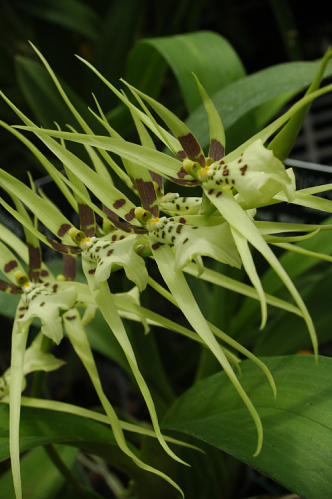
Brassia Rex, 2009-1460A, Smithsonian Gardens Orchid Collection.
It has long been believed that Brassias evolved flowers which—through a strategy known as brood site deception—mimic the appearance of spiders in order to attract female parasitic wasps of the genera Pepsis and Campsomeris that target spiders as hosts on which to lay their eggs. This ‘imitation’ strategy is evident in many types of orchids that use flower smell, color, and texture to appear to be suitable places for pollinators to deposit their progeny. Ecologists in Central America, however, have recently noted that while parasitic wasps do indeed visit Brassias and pollinate them, they do not appear to lay eggs on these orchids. As a result, this finding disproves brood site deception as the reason for Brassias’ spider-like appearance. While the true reason for the spider orchid’s form remains unknown, discussion at a recent orchid conference brought up the possibility that these wasps simply like the look of these flowers.
This raises a fascinating question I’ve been mulling over recently: Is it possible that there is an aesthetic component to orchid evolution? Charles Darwin thought this to be the case and pointed to the sexual selection of mates in various animal species as evidence. Perhaps pollinators also select showy flowers such as Brassias for their ‘attractiveness.’ This question has yet to be answered and is just one of the many reasons I find the mysterious field of orchid ecology so fascinating.
-Tom Mirenda, Smithsonian Gardens Orchid Collection Specialist
A Floral Firework Display: What’s Blooming in the Smithsonian Gardens Orchid Collection
Sunday is the final day of the 2016 orchid exhibit, Orchids In Focus, at the United States Botanic Garden (USBG). It has been an interesting season to say the least, with seventy degree weather in January and gusting winds throughout March. Most of our show plants are bloomed out and will start their recovery for next year’s blooming cycle. Our species orchids are not on such a rigid schedule and are still living the slow life in the greenhouses, blooming when they please and offering visual fireworks of color amidst the overwhelming background of green foliage.
Scaphyglottis bidentata is a dazzling miniature orchid from Central and South America. This species exhibits spectacular red-orange flowers, a pollination syndrome for ornithophily, or bird-pollination. Several other Scaphyglottis with large (relatively), bold flowers were previously classified under a distinct genus, Hexisea but were morphologically similar enough to the former Scaphyglottis grouping to be lumped together. One of the major defining morphological characteristics of species in this group is that the pseudobulbs are stacked (see inset photo).

(left) Scaphyglottis bidentata, (right) illustration from Edwards’s Botanical Register
Another striking pop of color found in our species greenhouse comes from Dendrobium bracteosum var. tannii. If you look this one up, you won’t find tannii mentioned anywhere because the name has never been formally published. This variety is a miniature form of the species. To give you an idea of the size difference the flowers on our specimen are no longer than a centimeter in diameter, which is less than half of the typical size.

Dendrobium bracteosum var. tannii
Dendrobium sanguinolentum is a pendant growing epiphyte found in Thailand, Western Malesia and the Philippines. This species is known as “The Blood Stained Dendrobium” because the flowers typically have splotches or stains of violet at the edges of the sepals and petals. The plant below may be an alba form of this species since there are no stains evident on the pale yellow flower.

Dendrobium sanguinolentum
This week’s grand finale is Myrmecocattleya Claudia Elena. This fantastic hybrid with such vivid coloration is a cross between Myrmecophila tibicinis and Cattleya dowiana. In the wild, the ranges of these two species do not overlap, but since they are both part of the Cattleya alliance, hybridizers are able to successfully interbreed them. Myrmecophila flowers are typically one to two inches in diameter, but when crossed with a large flowered Cattleya, they almost triple in size!

Myrmecocattleya Claudia Elena
Photographs are a wonderful way to explore nature’s diversity, but nothing compares to experiencing it in person. If you are in the Washington, D.C. area, make sure to take a final trip to the USBG to see our orchids on display before the exhibit ends on the 17th!
-Julie Rotramel, Living Collections Specialist
April 15, 2016 at 8:41 am smithsoniangardens Leave a comment
Three Cheers for Spring: What’s Blooming in the Smithsonian Gardens Orchid Collection
It’s finally spring! Today marks the fifth day past the Spring Equinox and it seems like nature is as ready as we are for the change in season. Around the city cherry and magnolia trees are bombarding the city with their pink blossoms and fresh fragrance. Splashes of color from daffodils and pansies are everywhere. Though the season’s change is much more gradual in our orchid greenhouses, this time of year still finds unparalleled variety and interesting stories to tell in our species collection.
This first species was part of a donation we received last summer. It entered our collection as Acianthera aculeata, but now that we have seen the plant in bloom, it doesn’t quite match the type description for the species. A proper identification will require more research for our orchid curators.
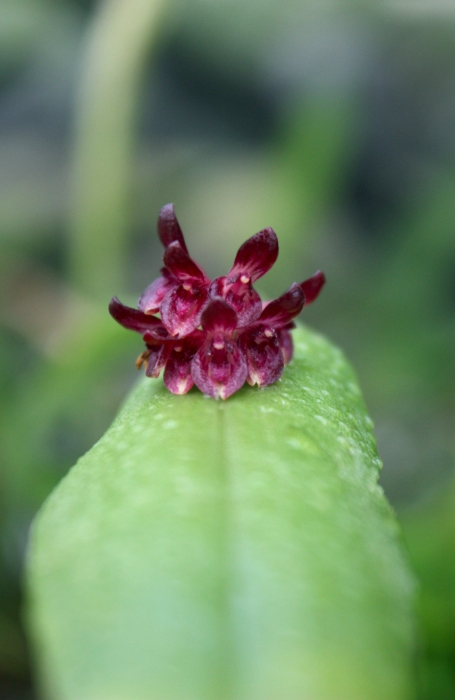
Acianthera sp.
Regardless of its specific name, one characteristic I find fascinating about this orchid and many other Pleurothallids is that the flower spikes arise from the base of the leaf rather than closer to the root structures. This makes the flowers appear to grow right on the leaf surface, which has an interesting effect. Many Pleurothallids are thought to engage in brood site deception, and it can be speculated that these small, wine colored flower umbels mimic the perfect egg-laying site for the plant’s pollinators.
Mediocalcar decoratum is a mat forming epiphyte found in the cloud forests of New Guinea. The miniature orange and yellow bell-shaped flowers are scattered evenly throughout the foliage like someone’s lost candy corn and lend a generally cheerful aspect to the plant. This may be why it is commonly known as the Charming Mediocalcar.
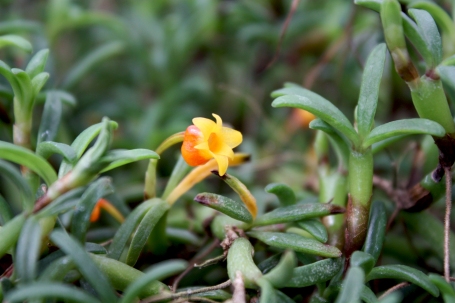
Mediocalcar decoratum
Last but not least is the ever popular Dendrobium secundum, commonly referred to as the Toothbrush Orchid. This often pendulous species is found throughout Southeast Asia. Its inflorescence of bright pink flowers opens successively (but not fully) at the end of a leafless cane giving it the appearance of bristles at the end of a toothbrush handle. The alba form is also quite beautiful with waxy white flowers and a yellow lip.
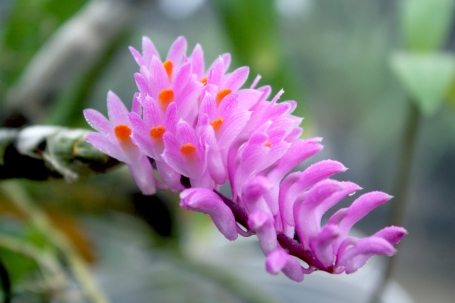
Dendrobium secundum
To see more of our collection, visit the orchid exhibit, Orchids In Focus, at the United States Botanic Garden now through April 17th.
-Julie Rotramel, Orchid Collection Specialist
March 25, 2016 at 8:15 am smithsoniangardens Leave a comment
A Tropical State of Mind: What’s Blooming in the Smithsonian Gardens Orchid Collection
It’s March and it definitely feels like spring. This week’s blooming orchid selections are inspired by the tropical weather we’ve been having the past few days. Our species greenhouse has been looking rather tropical as well…

First on our list this week is Bulbophyllum saurocephalum, which is an epiphytic Philippine species. This odorless plant is also known as the Lizard Head Bulbophyllum because of the numerous tiny flowers that seem to be rearing their striped heads from the surface of the rachis.
Another drastically different Bulbophyllum that is blooming not far from B. saurocephalum is Bulbophyllum compressum. This is a hot growing Indonesian species found at lower elevations, with beautiful, ovate floral bracts of up to 30 delicate,white flowers.

Bulbophyllum compressum
I tend to gravitate towards the strangeness of Bulbophyllums, but I recognize that there are many other genera that are equally fascinating and worthy of mention. Below is the tiny flowered Tolumnia bahamensis.

Tolumnia bahamensis
Not only is this a fascinating North American species, it is highly appropriate to our tropical theme for this week. This species starts its life as a terrestrial in sandy soil, and as it matures, will send out growths that attach to taller plants, transitioning to an epiphytic habit. Tolumnia bahamensis is only found in Atlantic coastal scrub habitats and is considered highly endangered. Atlanta Botanical Garden has been leading reintroduction efforts in Florida with much success.
To see part of the Smithsonian Gardens Orchid Collection on display, visit the Orchids In Focus exhibit at the United States Botanic Garden through April 27!
–Julie Rotramel, Living Collections Specialist, Smithsonian Gardens
March 11, 2016 at 10:00 am smithsoniangardens Leave a comment



